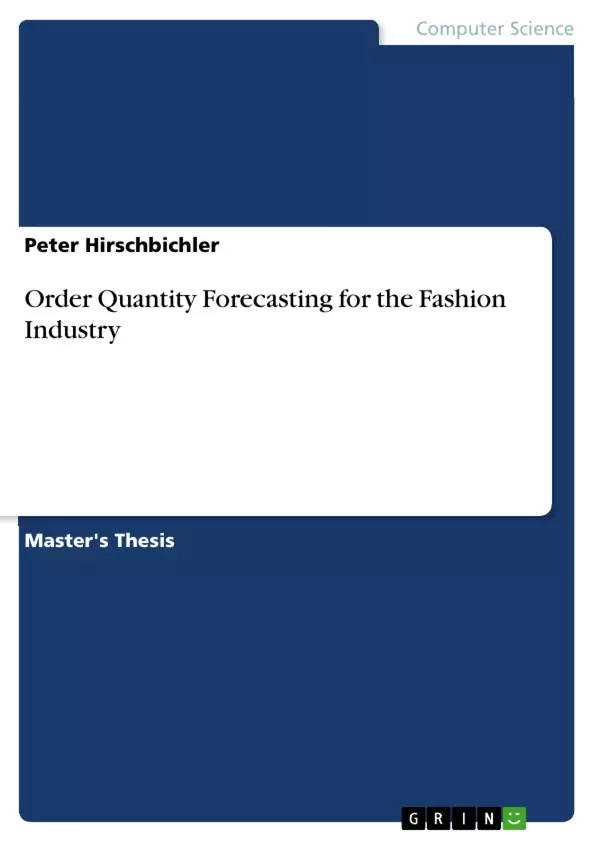Precise order quantity forecasting for fashion retailers is difficult, because of the specific nature of fashion products namely long lead times, seasonality, and product attributes such
as sizes, colours, and cuts. This thesis contributes to order quantity forecasting for fashion products by the use of regression analysis. For this purpose, forecasting techniques in general, and parametric as well as nonparametric regression analysis in articular are presented. This is followed by fundamentals of data mining, specifically data preprocessing and data warehousing, in order to be able to apply regression analysis on historical sales data. Furthermore, to examine the quality of forecasts a method for
evaluating the economical benefit of order quantity forecasting was developed.
As a next step, the presented methods for forecasting were applied to historical sales data. Therefore, sales data was analysed, regression models were applied and forecasts were
calculated and evaluated finally. This thesis is concluded by suggesting a forecasting implementation and by discussing the contributions to order quantity forecasting.
Inhaltsverzeichnis (Table of Contents)
- Introduction
- Fashion Business
- Characteristics of Fashion and Sports Equipment Products
- Problems of Fashion Purchasing
- Recent Developments in Fashion Purchasing
- Research Questions and Goals of the Thesis
- Outline of the Thesis
- Forecasting
- Fundamentals
- Sales Forecasting
- Sales Forecasting for Fashion Products
- Regression Analysis
- Fundamentals
- Parametric Regression Analysis
- Quality of the Estimated Regression Model
- Nonlinear Regression Analysis
- Nonparametric Regression Analysis
- Binning and Local Averaging
- Kernel Estimation
- Local Polynomial Regression
- Quality of the Estimated Nonparametric Regression Model
- Nonparametric Multiple Regression Analysis
- Data Mining
- Fundamentals
- Knowledge Discovery from Data
- Measurement Scales
- Preprocessing of Data
- Data Cleaning
- Data Transformation
- Normalisation of Interval and Ratio Scaled Data
- Normalisation of Ordinal Data
- Normalisation of Alpha Variables
- Data Reduction
- Data Warehousing
- Data Warehousing for Fashion Retailers
- Fundamentals
- Economical Quality of Forecasts
- Product Costing and Pricing
- Costs of Overstocking and Understocking
- Evaluating the Economical Quality of Forecasts
- Application of Forecast
- Calculating Regression Analysis by MATLAB
- Preliminary Examination of Data
- Data Description
- Data Preprocessing after Export from Data Warehouse
- Examinations of Sizes over Time
- Examination of Sizes during the Season
- Examinations of Sizes for the same Season over several Years
- Examinations of Sizes over Stores
- Forecast and Evaluation Process
- Modelling
- Univariate Approach
- Multivariate Approaches
- Surface Fitting Using a Parametric Polynomial Regression Model
- Surface Fitting Using a Custom Equation Regression Model
- Surface Fitting Using a Nonparametric Lowess Regression Model
- Forecasting
- Evaluation of the Forecast
- Hypothesis 1: Actual Sales Data Represents the Demand of Products
- Hypothesis 2: Actual Sales Data is Biased by Original Order
- Conclusions on Hypotheses
- Evaluation of the Forecast
Zielsetzung und Themenschwerpunkte (Objectives and Key Themes)
This thesis explores order quantity forecasting for fashion products, analyzing the challenges presented by long lead times, seasonality, and product attributes. It aims to improve forecasting accuracy by applying regression analysis techniques, focusing on both parametric and nonparametric methods. Key themes include:- The unique characteristics of fashion products and their impact on forecasting
- The application of regression analysis techniques to predict sales
- The importance of data mining and preprocessing for effective forecasting
- The development of a method to evaluate the economic benefit of accurate forecasting
- The practical application of forecasting models using real-world sales data.
Zusammenfassung der Kapitel (Chapter Summaries)
- The introductory chapter outlines the challenges of order quantity forecasting in the fashion industry, highlighting the unique nature of fashion products and the complexities of their purchasing process. It introduces the research questions and goals of the thesis, outlining its structure and scope.
- This chapter delves into the characteristics of fashion and sports equipment products, discussing the specific problems they pose for purchasing and forecasting. The chapter then explores recent developments in fashion purchasing, showcasing industry trends and innovations.
- Chapter three explores the fundamentals of forecasting, focusing on sales forecasting methods and their application to fashion products. The chapter provides a theoretical framework for understanding different forecasting techniques, preparing for the introduction of regression analysis.
- This chapter delves into regression analysis, covering its fundamentals and different approaches, including parametric and nonparametric methods. The chapter examines the quality of various regression models, providing insights into their strengths and limitations.
- Chapter five focuses on data mining, exploring its fundamentals and emphasizing the importance of knowledge discovery from data. The chapter delves into data preprocessing, including data cleaning, transformation, and reduction, laying the foundation for effective analysis and forecasting.
- Chapter six introduces the concept of data warehousing, highlighting its relevance to fashion retailers. The chapter discusses the role of data warehousing in providing valuable insights for better decision-making and forecasting.
- This chapter delves into the economic aspects of forecasting, focusing on product costing, pricing, and the costs associated with overstocking and understocking. It then introduces a method for evaluating the economic quality of forecasts, highlighting the importance of assessing the potential benefits of accurate predictions.
- Chapter seven presents a practical application of forecasting methods, demonstrating how regression analysis can be implemented using MATLAB. The chapter walks through the data analysis process, including data preprocessing and examination, and culminates in the generation and evaluation of forecasts.
Schlüsselwörter (Keywords)
This thesis focuses on order quantity forecasting for fashion products, utilizing regression analysis techniques to predict sales. Key concepts include the characteristics of fashion products, sales forecasting, parametric and nonparametric regression analysis, data mining and preprocessing, economic evaluation of forecasts, and practical application of forecasting models using MATLAB.
- Citation du texte
- Peter Hirschbichler (Auteur), 2010, Order Quantity Forecasting for the Fashion Industry, Munich, GRIN Verlag, https://www.grin.com/document/164751



